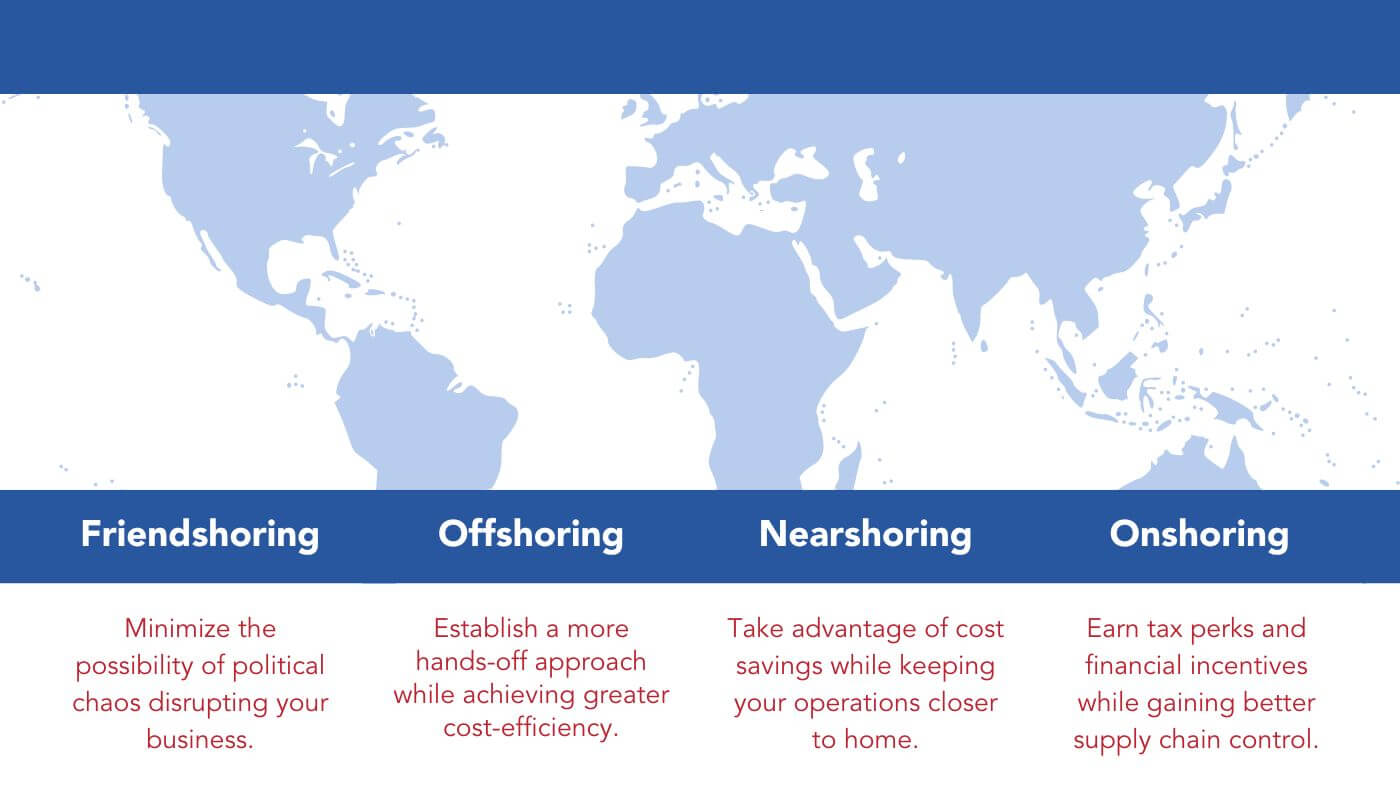
The COVID-19 pandemic, War in Ukraine, geopolitical tensions, and even weather disturbances have all created challenges for international trade in 2022. Combined, these different problems created a domino effect that disrupted the global supply chain.
Businesses of all sizes and industries dealt with shipment delays and steep tariff hikes, leading to empty stock shelves, inadequate inventory, and many unhappy customers.
According to a 2023 KPMG report, experts predict supply chain disruptions will continue throughout the year. To address this crisis and future-proof their operations, businesses must consider reinventing their trade strategies and diversifying their sourcing activities.
If you want to optimize your supply chain this 2023, learning the latest trends is necessary. Thankfully, this article can be your helpful guide in understanding a few of the trade buzzwords making headlines this year. Know the difference between friendshoring vs. outsourcing vs. offshoring vs. nearshoring.
Global Trade Buzzwords To Know in 2023: Friendshoring vs. Outsourcing vs. Offshoring vs. Nearshoring

Friendshoring
In the past, U.S. businesses prioritized cost when choosing a trade partner, and a country’s political situation had minimal impact on that decision. However, companies are becoming more conscious of how geopolitical tensions within a country affect their supply chains. And this is how the idea of “friendshoring” was born.
Friendshoring means relocating a company’s supply chain operations to a location that is considered politically stable, usually to an allied nation of its home country. Geopolitics is the primary consideration in this global trade solution, and businesses often choose countries where the chance of political chaos is low.
Another advantage of the friendshoring approach is that allied nations are more likely to have fewer language barriers and cultural barriers compared to other countries.
But Is Friendshoring Always a Good Idea?
Adopting friendshoring strategies makes sense, as it lowers the risk of supply chain disruptions. However, other experts argue that it is not the best idea for the global economy.
In a recent report, the World Trade Organization predicted that worldwide GDP would drop by 5% if countries decided to only trade within their list of allies, significantly impacting emerging economies.
Reshoring
Because of supply chain disruptions and an unstable international trade environment, many U.S. companies have adopted a reshoring strategy.
In simple terms, reshoring means returning a company’s manufacturing, production, supply chain, or other crucial processes to its home country. For example, many U.S. manufacturers offshored their factory operations to China in the past but are now establishing a local team in the United States.
Is Reshoring the Answer to Supply Chain Problems?
In a 2022 report, about 1,800 U.S. firms planned on returning their supply chains and workforces to their home country. Doing so allowed them to generate over 350,000 additional jobs for American workers, making this the highest number of reshored jobs in over a decade.
Although moving their operations back home can offer businesses greater control over their supply chain and stimulate their local economy, the most significant downside of reshoring is that it may drive up costs significantly.
At the same time, the United States is navigating an ongoing labor crisis, potentially making reshoring efforts, especially finding qualified in-house staff, more of a challenge.
Read More: Nearshoring vs. Reshoring: Which Is the Practical Response to Supply Chain Disruptions?
Onshoring
Some jobs are best done by professionals within your own country. Onshoring, also known as onshore or domestic outsourcing, is the process where companies delegate a part or all of their operations to a third-party provider in their home country.
Reshoring and onshoring are similar concepts, but the only difference is where operations began.
With reshoring, companies that previously delegated their processes offshore are returning their operations to their home country. For example, some IT companies in the U.S. outsourced their business processes overseas but are now investing in a development team in their home country.
Meanwhile, with onshoring, the company may have never outsourced processes beyond its borders but is working with a BPO provider within the same country. For example, instead of building an in-house team, a company based in New York can think about outsourcing development to a BPO in Pennsylvania.
Nearshoring
Nearshoring is the process of outsourcing all or part of your business operations to a BPO provider from a nearby country.
More and more companies are reaping the benefits of nearshoring and investing in trade partners closer to their country of origin. In fact, the Trade in Transition 2023 Report observed that nearshoring increased by ten percentage points compared to only two years ago.
Offshoring vs. Nearshoring: What’s the Difference?
Much like offshoring, nearshoring offers greater cost-effectiveness for businesses.
However, the main difference between offshoring and nearshoring is that the latter allows faster and easier collaboration because of shared time zones, geographical proximity, and cultural compatibility.
When necessary, U.S. business leaders can even take a short flight to their nearshore partner, lowering travel costs and avoiding time-consuming trips.
Where Should You Establish Your Nearshore Team?

As for which countries are becoming the go-to nearshore partners, some see Canada or Eastern Europe as options. However, many U.S. companies are overwhelmingly turning to South America, with Colombia being eyed as a top BPO destination.
Due to Colombia’s relatively stable economic conditions, the Latin American nation has become an especially desirable location for U.S. businesses’ outsourcing operations. Despite recovering from the COVID-19 pandemic, industry experts reported that Colombia’s economy grew by 5.5% in 2022 and is expected to grow by 3.1% in 2023.
Known as the Silicon Valley of Latin America, Colombia is also an attractive destination for software outsourcing. The right Colombian outsourced team can handle all parts of the software development process, helping companies gain access to a vast pool of tech professionals while also getting to save money.
Offshoring
Offshoring, also known as offshore outsourcing, is when a company moves part of its operations to a distant country. The main competitive advantage of offshoring is that businesses gain access to a broader pool of talent while also reducing overhead and labor costs.
Where Should You Establish Your Offshore Team?

For many U.S. businesses, call centers in the Philippines remain a strong contender for offshore BPO destinations. Outsourcing to this Southeast Asian nation gives companies access to a massive pool of skilled workers who often have excellent English communication skills, superb familiarity with and affinity for Western culture, and impeccable work ethics.
Renowned globally for being the “BPO Capital of the World,” the Philippines has a relatively stable economy, numerous favorable government regulations, and financial incentives for foreign companies that choose to establish their operations there.
Outsourcing
All five of the buzzwords mentioned above fall under the broader “outsourcing” umbrella. Outsourcing refers to the business practice of hiring a third-party company to take on part or all of a business’s processes, regardless of location.
In the past, outsourcing was primarily associated with call center operations, particularly customer service. However, more businesses today choose to outsource niche and specialized services, such as software development, recruitment, legal processes, healthcare, data science, multilingual support, and more.
Friendshoring vs. Offshoring vs. Nearshoring vs. Onshoring: Which Business Model Is Best for You?
The truth is that there is no right or wrong answer when it comes to choosing your ideal outsourcing strategy. You must first assess your specific business needs and goals before making a decision.

For industries where tax perks, time difference, and careful supply chain control are essential, onshoring can be the best way to go. According to research studies, companies choose to reshore their operations for two critical reasons: economic or market incentives and being geographically closer to customers.
Meanwhile, offshoring can provide an excellent strategic advantage for businesses with a more hands-off approach and are aiming for better cost-efficiency.
Suppose you don’t need to communicate with your chosen BPO provider in real time. In that case, offshoring can allow you to establish 24/7 operational coverage, resting easy knowing that your offshore team is getting work done even during your off-hours.
For companies that want to take advantage of offshore cost savings while keeping their operations closer to home, nearshoring can be the perfect compromise. By working with neighboring countries, you’ll have access to a skilled remote team at a relatively low cost.
At the same time, you’ll work in more similar time zones, speak the same language, and have fewer cultural differences, allowing for more effective communication.
To minimize the possibility of political chaos interrupting your processes, you can also consider ‘friendshoring’ to locations that are friendly to the United States (for example, offshore to the Philippines or nearshore to Colombia).
Harness the Best of All Worlds by Adopting a Hybrid Outsourcing Strategy
The international supply chain ecosystem has become intricately interconnected in today’s increasingly globalized world. To remain agile and competitive, it’s wise not just to choose one outsourcing model but adopt a strategy that combines all three.
Instead of keeping all resources in-house, why not work with a third-party firm offering a customized strategy that brings together different outsourcing models?
Blending onshore, offshore, and nearshore solutions can help you cover all bases, ensuring you’re not dependent on just one country.
If one country’s economic or political conditions suddenly change, you won’t have to cease or pause your operations because you didn’t put all your eggs in one basket. A hybrid outsourcing approach allows you to be more flexible and agile in the face of supply chain disruptions.






